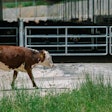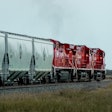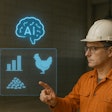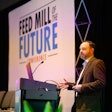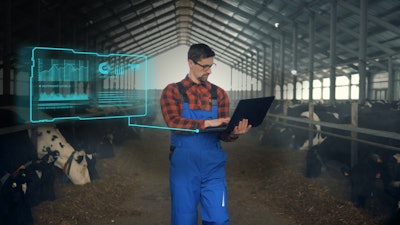
In the evolving landscape of agricultural innovation, precision nutrition has emerged as a promising paradigm of modern livestock management. As a critical component of precision livestock farming (PLF) — defined as the management of livestock using process engineering principles and technologies — precision nutrition represents a significant shift in how we approach animal feeding systems.
At its core, precision nutrition (also known as precision feeding) employs sophisticated techniques to deliver the right nutrients to the right animals at the right time. This approach transcends traditional feeding methods by leveraging a combination of real-time data on animal health and performance, dynamic formulation strategies, and automated feeding systems to fine-tune feed composition and amount based on specific animal requirements. By doing so, every animal or group of animals receives the optimal ration to support maximum production without overfeeding, which in turn benefits feed conversion rates and sustainability.
What makes precision nutrition particularly valuable in today's agricultural context is its ability to minimize the environmental impact of livestock farming without compromising animal performance and health. By tailoring nutritional inputs to precise biological needs, farmers can optimize resource utilization while supporting sustainable livestock production practices.
Why it matters
The landscape of livestock farming has undergone a dramatic transformation in recent decades, evolving from small-scale operations serving local needs to today's intensive, industrial-scale production systems. This shift, while increasing productivity, has introduced a complex set of challenges for modern livestock producers. These challenges include uncertainties in international trade regulations, diminishing government support, heightened societal expectations regarding animal welfare and environmental standards, escalating production and feed costs, and growing food-feed competition for plant protein sources.
In response to these mounting pressures, precision nutrition has emerged as a strategic solution offering multiple advantages. First and foremost is its contribution to efficiency — with feed representing the most significant expense in livestock production, precision nutrition minimizes overfeeding and nutrient wastage, resulting in improved feed conversion ratios and subsequently lower production costs.
The minimization of feed waste also has significant environmental benefits, as overfeeding often leads to excess nutrient excretion, contributing to environmental problems such as nitrogen leaching and phosphorus runoff.
Research demonstrates impressive results: for growing pigs, for example, individually tailored daily diets can help farmers produce the same amount of meat while reducing lysine provisions by 25%, feeding costs by 8% and nitrogen and phosphorus excretion by nearly 40%.
Furthermore, greenhouse gas emissions can be reduced between 6% and more than 24%. This is particularly significant considering that feed accounts for 70% of the environmental impact in pig and poultry production.
Implementation challenges
Even though precision nutrition has been recognized as perhaps the most promising avenue to reduce the environmental footprint of livestock production systems, including greenhouse gas emissions, its implementation at the farm level presents significant challenges despite its promising benefits.
Given the extensive range of available monitoring technologies and sensor systems, enthusiasts may be inclined to implement multiple solutions simultaneously without strategic prioritization or integration planning. Instead, it is crucial to concentrate on identifying the most appropriate and relevant information needed for the optimal functioning of precision nutrition applications and choose technology and sensors based on specific needs.
These technologies, while essential for gathering real-time information on livestock health and feed consumption patterns, often represent prohibitive costs for medium and small-scale producers. Conducting a comprehensive needs analysis and technology assessment will optimize capital allocation for data infrastructure investments, thereby minimizing unnecessary expenditures while maximizing operational value.
Another inhibitor is that farms frequently encounter difficulties in data management and integration, as information flowing from multiple sensor types, automatic precision feeders, milking machines, scales, animal identification systems and other monitoring systems must be harmonized into actionable insights. For producers wanting to take precision livestock farming to the next level, the development of fully integrated and automatic systems is essential, because expecting farmers to separately operate and integrate all these different components is unsustainable and counterproductive.
Farmers are biologists by nature and technologists only occasionally. Although they invest in technology, it is typically machinery they look forward to buying, not software, sensors or services.
The critical role of software in precision nutrition
Integrated software platforms serve as the essential neural network for precision nutrition systems, seamlessly unifying diverse data streams from multiple sensors and technologies into actionable intelligence.
For example, comprehensive ration formulation tools can stand as the cornerstone of effective precision nutrition implementation as such platform can centralize individual animal data — including production stages, lactation data, growth metrics and other performance metrics — and integrate them with animal models to generate individualized nutrition prescriptions precisely calibrated to each animal's specific requirements. If the system has the capability to incorporate farm-specific raw material analyses, such as on-site grains or roughage quality, it enables the ration formulator to use the exact nutritional profiles available rather than relying on standardized values.
Beyond productivity metrics, a system can incorporate robust sustainability analytics that quantify environmental impacts including greenhouse gas emissions, water utilization, land-use efficiency, and eutrophication potential. A multidimensional approach to optimization can allow producers to formulate rations that simultaneously enhance feed conversion efficiency while minimizing ecological footprint — a critical balance that addresses economic and environmental imperatives in modern livestock production systems.
The future of precision nutrition
As we look toward the horizon of agricultural innovation, precision nutrition stands as a beacon of sustainable intensification — a pathway to meeting growing global demand for animal protein while simultaneously minimizing environmental impact. The evolution of this technology will likely see increasing accessibility for small and medium-sized operations through more affordable sensor technologies, cloud-based platforms and subscription service models.
The future of precision nutrition lies not just in technological advancement but in its seamless integration into holistic farm management systems. We can anticipate the emergence of comprehensive platforms that unite nutrition, health monitoring, genetic information and environmental conditions into predictive models, potentially even using artificial intelligence to build models that outperform the animal models used today.
Embracing precision nutrition represents a challenge and an opportunity. Those who develop expertise in dynamic formulation strategies and individualized nutrition programs will position themselves as essential partners in the future of livestock production. Ultimately, precision nutrition isn't merely a technological upgrade — it's a fundamental reimagining of our relationship with animal nutrition, one that promises to deliver healthier animals, more profitable farms and a more sustainable planet. In a world of increasingly scarce resources and growing environmental concerns, the ability to do more with less isn't just smart business — it's responsible stewardship.







